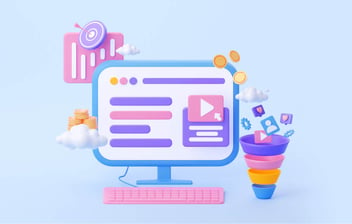Marketing strategies today are more varied than ever, and businesses must choose the best approach to reach their audience. Two of the most widely used methods are inbound marketing and outbound marketing, each offering a distinct way to connect with potential customers.
Inbound marketing attracts customers by offering helpful, relevant content that addresses their needs or problems. This approach builds trust and nurtures relationships over time.
On the other hand, outbound marketing pushes a brand’s message out to a wide audience through channels like TV ads, cold calls, and direct mail. This method seeks to grab attention quickly but often lacks the personalised touch of inbound marketing.
Understanding the difference between inbound and outbound marketing is crucial when deciding how to approach your marketing efforts. The decision between inbound marketing vs outbound marketing really comes down to what your business is aiming for, who you’re targeting, and the resources you have on hand.
In this blog, we’ll explore the distinctions between the two strategies and offer insights on how each can be used effectively for your business.
What is Inbound Marketing?
Inbound marketing focuses on pulling in potential customers by offering helpful content that speaks to their needs. It’s not just about promotion but more about engaging with them in a way that adds value. Instead of interrupting the audience with ads or cold outreach, it pulls them in naturally by addressing their needs and interests.
The key to inbound marketing is providing value—whether it’s through blog posts, videos, social media content, or e-books. Inbound marketing builds trust over time and keeps leads interested until they’re ready to make a decision.
Benefits of Inbound Marketing
- Attracts qualified leads by engaging people actively searching for solutions, resulting in higher-quality prospects.
- Builds trust and nurtures long-term relationships with your audience through valuable content.
- Typically, lower costs over time, especially through SEO and organic traffic.
- Easy to track performance with analytics tools, allowing for continuous optimisation.
- Focuses on helping rather than interrupting, creating a positive customer experience.
What is Outbound Marketing?
Outbound marketing often called traditional marketing, involves pushing messages out to a wide audience through methods like TV ads, cold calling, direct mail, and display advertising. It aims to reach as many people as possible, hoping that some will respond to the message.
While outbound marketing can reach a larger audience, it’s often seen as interruptive and can lead to lower engagement rates compared to inbound marketing.
Benefits of Outbound Marketing
- Delivers your message quickly to a large audience through ads, TV, or cold calls.
- Effective for building broad visibility and recognition, especially for new products or brands.
- Great for generating quick exposure or promoting time-sensitive offers.
- Allows businesses to craft and deliver a clear, focused message to a wide audience.
- Particularly useful in industries where traditional advertising is still widely consumed.
Inbound Marketing vs Outbound Marketing: Key Differences
Understanding inbound versus outbound marketing can help businesses choose the right approach based on their goals and audience. Here is the difference between inbound and outbound marketing based on how these two strategies differ in their tactics, focus, and impact:
| Aspect | Inbound Marketing | Outbound Marketing |
| Approach | Inbound marketing focuses on pulling potential customers in by providing valuable, relevant content that solves their problems or answers their questions. The aim is to naturally attract leads by being helpful rather than directly promoting products or services. | Outbound marketing pushes messages out to a broad audience, often interrupting them with ads or promotions. It’s a more aggressive, direct approach to getting in front of as many people as possible, hoping some will respond. |
| Audience Engagement | Inbound marketing encourages two-way communication. It builds relationships by engaging with the audience through blogs, social media, and email marketing. It nurtures leads over time, creating trust and fostering a meaningful connection with the brand. | Outbound marketing is typically one-way communication. It broadcasts messages with the hope that they will resonate with the audience, but it rarely involves direct interaction or engagement until after the lead has been captured. |
| Content Strategy | Inbound strategies rely on educational, informative, and problem-solving content. This can include blogs, eBooks, webinars, and infographics that provide real value. The content is designed to nurture leads by addressing their needs at different stages of the buyer’s journey. | Outbound content is usually promotional and sales-driven. It’s focused on direct offers, product features, and branding. This could include TV or radio ads, cold calling, and direct mail campaigns that promote products or services directly. |
| Cost | Inbound marketing is often more cost-effective over time. Although initial investments in content creation, SEO, and social media management are required, the long-term benefits, like ongoing organic traffic, often make it more affordable compared to continuous ad spending. | Outbound marketing can be more expensive, especially when it involves traditional media such as TV, radio, or print ads. The costs of placing ads and direct mail campaigns can add up quickly, with results that are often less measurable. |
| Targeting | Inbound marketing allows for highly targeted content. It attracts a well-defined audience by using techniques like SEO, keyword optimisation, and personalised email campaigns, ensuring you’re speaking to those who are most likely to be interested in your product or service. | Outbound marketing casts a wider net, often reaching a broader audience without much precision. TV commercials or billboards, for example, may reach thousands of people, but many of them may not be interested or qualified leads. |
| Lead Generation | Inbound marketing generates highly qualified leads because it attracts people who are already looking for solutions or information related to your offering. These leads are often warmer and easier to convert because they have shown interest by engaging with your content. | Outbound marketing generates less qualified leads, as the audience is typically not actively seeking your product or service. Cold calls or unsolicited ads might generate leads, but they often require more effort to nurture and convert. |
| Measurability | Inbound marketing is highly measurable. Digital tools like Google Analytics, HubSpot, or SEMrush allow you to track key metrics such as website traffic, lead generation, conversion rates, and engagement levels. You can monitor every stage of the funnel and adjust your strategy based on data. | Outbound marketing is harder to measure precisely. While you can track some metrics like impressions or ad clicks, it's more difficult to measure the direct impact of a TV commercial, billboard, or radio ad on lead generation and conversion. |
How to Choose Between Inbound and Outbound Marketing
When deciding which strategy to use, it’s important to consider your business goals, audience, and budget. Both inbound and outbound marketing can be effective, but their success depends on how well they align with your overall strategy.
Choose Inbound Marketing if:
- You want to build long-term relationships with your audience.
- Your target audience spends time online searching for solutions.
- You’re looking for a cost-effective, scalable strategy.
- You prefer measurable tactics, such as SEO, social media, and email marketing.
Choose Outbound Marketing if:
- You need immediate visibility and brand awareness.
- You have the budget for large-scale campaigns like TV, radio, or paid ads.
- Your product or service appeals to a broad audience.
- You’re running short-term promotions or events that need instant exposure.
Combining Inbound and Outbound Marketing
While inbound and outbound marketing have clear differences, they don’t have to be mutually exclusive. Many successful businesses use a combination of both strategies. For example, you can use outbound marketing to create brand awareness while relying on inbound marketing to nurture leads over time.
A balanced marketing strategy can offer the best of both worlds: fast visibility and long-term engagement. Combining paid ads with engaging content or social media efforts ensures that you’re reaching your audience at multiple touchpoints.
ScaleStation Inbound Marketing Services: Driving Long-Term Growth
Choosing the right inbound strategy is key to forming real connections with your audience and helping your business grow steadily. At ScaleStation, our inbound marketing services are designed to help businesses attract, engage, and convert leads by offering personalised and valuable content that speaks directly to their target market.
We focus on creating content that answers your audience's questions and provides solutions to their pain points. Our services include:
- Content Strategy and Creation: Develop engaging content like blog posts, articles, videos, and more that align with your audience's needs and drive organic traffic.
- SEO and Lead Generation: Ensuring your website and content are optimised for search engines, helping your business rank higher and attract qualified leads.
- Email Marketing and Automation: Nurturing prospects with personalised email campaigns that guide them through the buying journey.
- Social Media Management: Creating and sharing content on social platforms to engage your audience and strengthen your brand presence.
With ScaleStation’s inbound marketing expertise, you can grow your business by delivering content that resonates with your audience, building trust, and converting leads into loyal customers. Want to know more? Connect with our inbound marketing experts now.
Conclusion: Which Strategy is Right for You?
Inbound and outbound marketing each has its strengths and can be effective when used in the right context. Inbound marketing is great for building long-term relationships, attracting qualified leads, and being cost-effective. In contrast, outbound marketing works well for creating immediate awareness and reaching a broad audience quickly.
The key is to understand your business goals and audience, then choose the inbound marketing strategy or outbound marketing strategy (or combination of strategies) that best fits your needs. With the right balance, you can create a marketing plan that drives both immediate results and sustainable growth.
FAQs
What is an inbound marketing funnel?
An inbound marketing funnel guides potential customers through stages of awareness, consideration, decision, and delight, using valuable content to attract, engage, and convert leads into loyal customers.
What is inbound funnel vs outbound funnel?
An inbound funnel focuses on attracting and nurturing leads through valuable content. In contrast, an outbound funnel pushes messages to a wide audience via ads or cold outreach, often interrupting their experience.
What are the four stages of inbound marketing methodology?
The four stages are Awareness, Consideration, Decision, and Delight. Each stage helps move prospects from discovering your brand to becoming loyal advocates.
How do you create an inbound funnel?
To create an inbound funnel, define your target audience, create tailored content for each funnel stage (awareness, consideration, decision, delight), and use tools like email marketing and automation to nurture leads and measure performance.
What is a b2b inbound marketing funnel?
A B2B inbound marketing funnel is a process that guides business prospects through stages of awareness, consideration, decision, and delight using tailored content. It focuses on attracting potential business clients with valuable information, nurturing relationships through educational content, and providing solutions that meet their needs. The goal is to build trust, turn leads into customers, and create long-term business partnerships.



![15 Effective B2B Inbound Marketing Strategies and Techniques with Examples [2024 Edition]](https://scalestation.io/hs-fs/hubfs/15%20Effective%20B2B%20Inbound%20Marketing%20Strategies%20and%20Techniques%20with%20Examples.webp?width=94&height=94&name=15%20Effective%20B2B%20Inbound%20Marketing%20Strategies%20and%20Techniques%20with%20Examples.webp)


![15 Effective B2B Inbound Marketing Strategies and Techniques with Examples [2024 Edition]](https://scalestation.io/hs-fs/hubfs/15%20Effective%20B2B%20Inbound%20Marketing%20Strategies%20and%20Techniques%20with%20Examples.webp?width=352&name=15%20Effective%20B2B%20Inbound%20Marketing%20Strategies%20and%20Techniques%20with%20Examples.webp)
